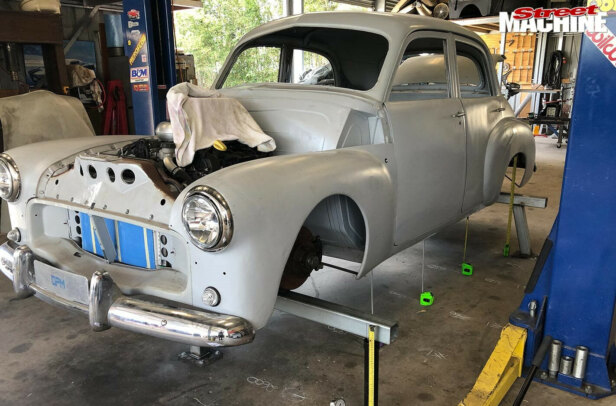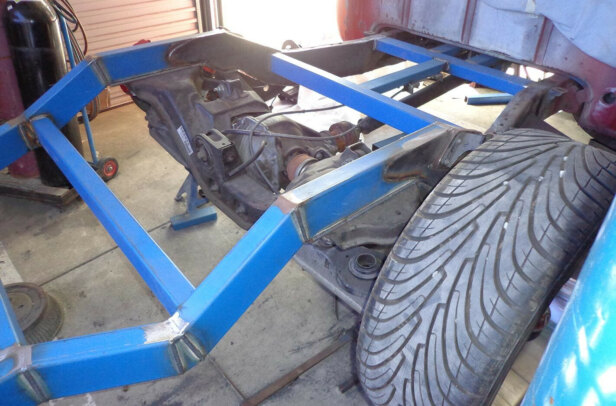WHEN a new model of a car is produced, you’ll sometimes hear that “the new chassis is x per cent stiffer”. But I’m guessing that most people’s response to that is simply: “So what?”. While everyone knows the advantage of more power, almost no one will be able to tell you the benefit of a chassis with a high degree of torsional rigidity. But increasing your chassis’ stiffness should be cause for celebration, as it will improve ride comfort by allowing the suspension to work more efficiently.
This article was first published in the April 2020 issue of Street Machine
Torsion is the twisting of an object (usually a shaft) due to an applied torque. When you apply a torque to a shaft, the shape of the shaft, its cross-sectional area and the elasticity of its material will dictate how much it twists. Round shafts will have a lower angle of twist than a square, all other factors being equal. A shaft that is double the size of another will have just 1/16th of the twist angle as the smaller-diameter shaft. That’s one reason why rollcage diameters are set by controlling authorities for racing applications.
Turning to vehicle body frames, the torsional rigidity of the total assembly is how much the frame will flex as it’s loaded when one front wheel is up, the other front wheel is down and the rear of the car is held level. This condition is seen at every corner on the road, so its importance to good handling should be obvious.
Convertibles, for example, have terrible rigidity. Take any sedan with an impressive torsional rigidity and turn it into a convertible and you’ll be lucky to get half of what you had. The door openings become a massive weak point once the roof support is removed. Even after the factory adds weight with an X-member and supports under the floor, there is still no substitute for a roof when it comes to stiffening up a chassis. We know from previous In Theory articles that depth of section is king and, when it comes to the twisting of a tube, diameter is everything. So adding material in a flat plane does little compared to these sensible engineering options.
In the simplest terms, vehicles that have high torsional rigidity deliver a superior ride, better handling and sharper response to driver inputs.
If you want your project car to be a comfortable, sure-footed cruiser, start by making your chassis as stiff as possible. Convertibles have particularly bad torsional rigidity due to the lack of a roof
Improving the torsional rigidity allows the suspension to work more efficiently and predictably. Considering the suspension uses dampers and the chassis doesn’t, it makes sense that we want the suspension to move and not the chassis. Increased rigidity also diminishes rattles, squeaks and rubbing points.
The chassis or unitary-construction body can be thought of as five independent springs. There are two front springs, two rear springs and the chassis itself, which acts as a fifth spring. The weakest spring in the series will deflect the most for a given load. This is why some vehicles don’t respond favourably to high-rate suspension springs unless the chassis rigidity is improved first.
For a street-car chassis, triangles and X-designs are usually evident in torsional rigidity solutions. So look for solutions made of high-rigidity materials and sections that incorporate these geometries. The second step is to look at a vehicle in three parts: front, centre and rear. The front is anything up to the firewall, the middle is the firewall to the rear seat, and the rear is anything behind the rear seat.
In the front section, it is critical to triangulate the subframe back to the firewall or, in a modern car, to the dash crossmember. We’ve seen this principle since the early Y-frames on an FJ Holden or the spring towers on early Falcons. Bracing the suspension loads back to a strong area of the cabin gives great results via the triangle. But we often see street machines with unsupported tubular front rails and have to wonder what they drive like. The belief that a pair of railway irons in a flat-plane chassis is a good idea is not sound. It fails in torsion and beaming and takes us back to the days of the Model T.
In the centre area, enclosing centre-pillar ‘top hats’, boxing in open pressings in the roof structure and installing a round-tube dash crossmember to link the front pillars/bulkhead will all dramatically improve cabin rigidity. So will stitch-welding weaker zones to strengthen spot-welded areas.
Triangulating a frame behind the back seat creates a rear bulkhead that can significantly strengthen the rear of the cabin in shear and torsion and act as a base structure to attach other bracing to. Remember also that the firewall is essentially a shear plate when the chassis or subframe is in torsion, so putting more shape into a flat one or adding stiffeners on the rear will give good results. Linking the door sills across the body is also critical, since these are the structural members of the cabin section.
In the rear, the best thing is to link the frame behind the rear seat back to the upper spring mounts and/or wheel tubs. The rear suspension and the front suspension will then be linked to the cabin to create a strong and rigid module. Connecting this rear bulkhead to the rear rails by framing around the upper bootlid zone also creates depth of section and ties these elements together.
If you really want to improve the rigidity of your ride, add a well-designed rollcage – you’ll be stoked with the results. Remember that rules apply to their fitment, which need to be considered for your application, legality and practicality.
The bottom line is: Designing and building a chassis or subframe with the right level of torsional rigidity and minimum weight is the desire of every chassis engineer and competent street machine builder. Advances in designs by modern auto-makers have created vehicles that offer up to 10 times the chassis rigidity of cars built 30 years ago. This has been achieved by triangulating the front and rear back to the cabin to create a rigid centre module that carries the suspension loads, while the front and rear extremities allow for impact crush. Street machiners can observe these ideas and use them cleverly in projects.
While most of this discussion has revolved around vehicle handling as a result of having a well-engineered chassis, those building big-horsepower machines have the added goal of restraining all that power so that it gets to the wheels. Torsional rigidity is doubly important to these guys, as are the principles for obtaining it.
While we can’t always afford the best chassis as a starting point, there are weld-in and bolt-in solutions for improving rigidity. We’ve talked a lot about depth-of-section and triangulation before, so for those building ground-up projects, the tools are there for you to engineer a fantastic vehicle where rigidity is built in as you go via clever fabrication work.




Comments